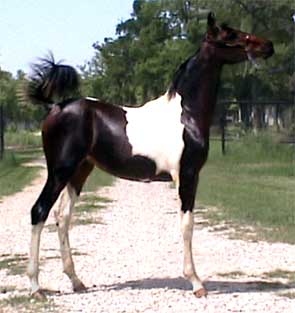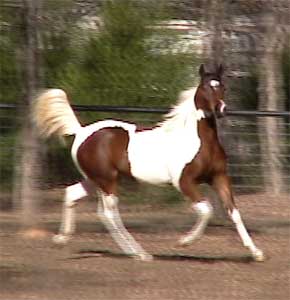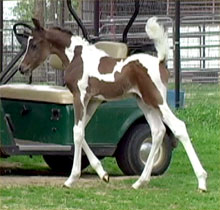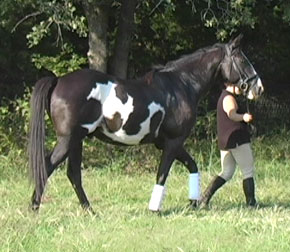If a horse is Homozygous Black
why are the foals Black and Bay colored?
What is the Homozygous Black Gene?
A foal inherits 2 genes for base coat
color, 1 from each parent. A base coat is either red or
black.
Bay, Palomino, Tobiano, Grey horses are all the result
of a modifier gene acting upon the base coat color.
The red coat color in horses is inherited
as a trait recessive to black. A blood test for the red
factor, based on DNA analysis, provides the information
to determine what color offspring a horse can throw. The
absence of the red factor presents itself as "E".
"E" = no red factor detected.
The horse can be assumed to be homozygous for black pigment
(EE). It cannot have red foals (chestnut or sorrel) regardless
of the color of the mate. The basic color of the horse
will be black or bay, but depending on genes at the other
color loci, the horse may be buckskin, zebra dun, grulla,
perlino, gray, white or any of these colors with the white
hair patterns tobiano, overo, paint, roan or appaloosa.
A Bay horse is a horse with a base coat
of Black with a modifier gene called the Agouti gene that
restricts the Black color to the points of the horse such
as the stockings, mane and tail. A horse can carry 1 copy
or 2 copies of the Agouti gene depending upon what each
of the horse's parents contributed. A chestnut (red) horse
can carry the Agouti genes but the genes will not affect
the base red coat color of the chestnut horse. The only
horse that you can look at and tell visibly that the horse
does not carry any Agouti genes is the Black horse that
looks Black.. If a Black horse had the Agouti gene it
would look Bay. UC Davis as well as Vet Gen can test for
the base coat color of Black/Red as well as the Agouti
genes with DNA testing.
What does it mean to be homozygous tobiano?
The tobiano modifier gene is a dominant gene and it only takes 1 copy for the foal to be a colored tobiano pinto. When a homozygous tobiano (TOTO) is bred with a solid (toto) the result is always a colored tobiano foal with the geneotype of ( TOto).
Genetic testing is available to help determine the presence of the Tobiano gene. Originally, there was no direct test for Tobiano, the early Tobiano tests utilized six genetic markers, including a marker on the KIT gene on Horse chromosome 3, which were closely linked to Tobiano but could not be used to officially prove homozygosity. However, in 2008 it was determined after some years of research from the University of Kentucky, that Tobiano coat pattern is the result of a chromosomal 'inversion' of the KIT gene. This inversion was finally mapped for genetic testing and is now offered by some laboratories as a more direct Tobiano assay. Testing is most often intended to determine Homozygosity, but is also useful in cases whereby a horse has greyed out, or if a horse has an unexplained loss of pigmentation.
According to Dwight Bennett, DVM. PHD (Perfect Horse February 2006), "When a horse that is homozygous for a pattern is mated with a horse of any color, all offspring will have the pattern. For example, if a homozygous tobiano (TT) stallion is bred to a gropu of chestnut, black, bay, dun and palomino mares, all of the offspring will be Tt and will have the tobiano pattern." "If a patterned stallion (or mare) has even one foal without the pattern, you can be certain that the parent horse is heterozygous for the pattern." Heterozygous tobiano means the horse has only one copy of the tobiano pattern and is therefore not homozygous. So in summary - Once a horse that is believed to be homozygous tobiano produces a solid, they can no longer be considered to be homozygous tobiano although they may have produced a high percentage of colored tobianos and thus can be marketed as a high percentage color producer.
Sadly some breeders are less than honest and will market a stallion as being homozygous for the tobiano gene when the stallion has produced solids. They will try to tell you unsubstantiated personal theories on why their alleged homozygous stallion occassionally does not throw tobiano color. They often base their claim on the old homozgyous tobiano testing done prior to the 2008 Univ. of Kentucky tobiano testing that was not 100% accurate. A horse that produces any non-tobiano colored foals is not homozygous for tobiano. A horse bred to at least 10 solid colored mates that has only tobiano foals is statistically 99.9% certain to be homozygous. " Read more on their webpage: http://www.vgl.ucdavis.edu/service/horse/tobiano.html
DNA testing is becoming more sophesticated as each year passes. Color genetics is fun and interesting, but there are a lot of people who are not accredited DNA scientists working within an accredited scientific DNA program that have opinions on why things happen. Just like urban legends and myths, anything can be published on someone's personal website expressing their opinion, but it is just that... their opinion. Always validate information with that from accredited research universities and laboratories. Please visit one of the accredited DNA Veterinary University sites below to keep up to date on the latest in DNA testing available for color genetics.
If my
Pinto Arabian is a higher percentage of Arabian, will
it look more Arabian in type?
Arabian
type is not a factor on how much percentage of Arabian
blood the foal has. Some purebred Arabians look more half-Arabian
than some half-Arabian horses. It is just a matter of
of how dominant the genes that give the "Arabian
look" are in the foals parents and whether or not
the nonArabians genes accentuate or detract from the Arabian
look.
 Saddlebred
crosses with Arabian horses tend to accentuate the longer
legs, longer neck, flatter croup, tipped ears, higher
leg action. Negatively the Saddlebred cross can narrow
the chest, lose hip and gaskin muscling, result in crooked legs that wing or paddle while they are preforming their higher gatied actions, lengthen and straighen the Arabian
head, remove the dish and decrease the size of eye. Sickle
hocks, long back and lardosis (sway back) can be an inherited fault
through the Saddlebred cross.
Saddlebred
crosses with Arabian horses tend to accentuate the longer
legs, longer neck, flatter croup, tipped ears, higher
leg action. Negatively the Saddlebred cross can narrow
the chest, lose hip and gaskin muscling, result in crooked legs that wing or paddle while they are preforming their higher gatied actions, lengthen and straighen the Arabian
head, remove the dish and decrease the size of eye. Sickle
hocks, long back and lardosis (sway back) can be an inherited fault
through the Saddlebred cross.
The Pinto Saddlebred Arabian cross tends to differ in
disposition from average purebred Arabian foals. In the
beginning they can be more aloof and reactive towards
strange things or during processes they decide they don't
care for. Patience and Parelli training can work wonders.
Start early with your training and handling these foals because
if fed properly they get tall pretty quick albeit with very
narrow chests a lot of the time. One should be aware that young horses will have more of an Arabian look to them. Even a lot of purebred American Saddlebreds when pictured as weanlings will have a shorter nosed dish type head. But the American Saddlebred infuence will start to show itself in the head as the horse starts to turn 2 to 3 years old. The nose will lengthen and lose a lot of dish, the eye placement will appear to move farther up the horse's head as the nose lengthens and straightens. If an Arabian short dished head is important to you, you should look at full siblings that are 3 years old or older to see if the head type is something you still desire.
Paint
Arabian crosses can accentuate the head by fortifying straight legs and good feet, increasing
the jowl definition, large eyes, width between the eyes
which can result in a very extreme head such as seen in
My JigSaw Puzzle CTA who is half-
Paint half-Arabian.  The
Paint can also accentuate the width of chest, hindquarters
and bone substance. Negatively the Paint cross can end
up with short legs, short fat neck , a bull dog type
of body, sloping croup, rump high, very flat kneed action and no tail set. Keeping this in
mind, our Paint stallion, Leo Dakota, was chosen for his
large jowl, big eyes and wedge shaped face, long well
shaped neck , hunter movement, race bred body type, comparatively level
croup with high tail placement.
The
Paint can also accentuate the width of chest, hindquarters
and bone substance. Negatively the Paint cross can end
up with short legs, short fat neck , a bull dog type
of body, sloping croup, rump high, very flat kneed action and no tail set. Keeping this in
mind, our Paint stallion, Leo Dakota, was chosen for his
large jowl, big eyes and wedge shaped face, long well
shaped neck , hunter movement, race bred body type, comparatively level
croup with high tail placement.
The disposition of the
Paint Arabian cross foals tends to be less reactive and
more accepting of new things as compared to a purebred
Arabian foal. They are bolder and more inquisitive. They
have a tendency to be a little thick skinned when it comes
to pressure training. Where a slight tap would send a
purebred Arabian jumping, you will be lucky if your Paint
Arabian foal notices it. The thick skin and boldness is
a positive when training for traditional spooky items
but can be a drag when you want light responsiveness. It
can be done, but it takes Patience. Parelli training
can really help. Start early with your handling and training,
, these foals get stout with some muscle early on with
big chests and powerful hindquarters. The head type of the Paint Arabian cross tends to get a deeper very defined jowl with usually a comparatively short nose and head when viewed from the side after 2 to 3 years of age.
There is no one horse type that everyone agrees on as
best, so Pinto Arabians can look substantially different
in type depending upon the characteristics of the NonArabian
Pinto bloodline the breeder has chosen to accentuate.
How tall will my Pinto
Arabian or Arabian horse grow?
Pinto
Arabians just like purebred Arabian horses usually mature
around the same height as their parents. The apple does
not fall far from the tree, so to speak. When both parents
are very dissimilar in size such as one parent being 14.1H
and one parent being 16H, the foal will usually fall somewhere
in between the heights. If the smaller horse is the dam
the foal may tend to be smaller than if the dam was the
taller one.
It is often seen that a mare's first foal will be smaller than subsequent full siblings that will be born later. This may be mother nature's way of ensuring that the first foal that passes through the birth canal is not too large, or maybe it is that the uterus is smaller as compared to a mare that has had several foals, regardless it seems to happen enough times. On the other end of the spectrum, older mares tend to have smaller and smaller foals, which maybe due to the older mare's uterus not being as nourishing as the uterus of a younger mare. Most things in life follow a bell shaped histogram, and if we look at the sizes of full siblings, we tend to see the bell shape for size of foal in birth order following suit to that same bell shape, with both ends being a little smaller than those in the middle.
Often one will see a horse that has parents
that are substantially taller than that horse ends up being
at maturity.
Heredity plays one part of the equation on how tall the
horse will end up being, but environmental factors can
substantially alter the final outcome. If a foal does
not receive the needed free choice exercise and higher
protein, mineral and vitamins requirements of a growing
horse, the foal can end up stunted. Illness and not placing
the foal on a monthly wormer program can also stunt a
foal from reaching his maximum height potential that his
genes say he should grow. Foals can have worms passed
to them through their mother's milk as well as picking
eggs up off the mother's body (bot eggs), or from mouthing
the environment. Foals when wormed as early as 30 days
old, can show evidence of killed parasites in their manure.
It takes only a matter of weeks for some species of worms
to become mature enough to start to do damage. We like
to use a worming product such as SafeGard or Strongid
on a monthly rotation until the foal is 3 months old,
at which time we will start using Ivermectin in the rotation.
Foals can grow taller or end up shorter than their parents.
If the foals parents did not reach their maximum heights
due to environmental conditions the parents genes still
have the ability to pass the size on to their offspring
or conversely if a foal's parents reached maximum height
due to environmental conditions but the foal does not
receive such care, or has an extended illness, or was born a twin , the foal can end up smaller.
A faster growing foal who is taller at 1 year old, may
not necessarily end up taller than one that is shorter
at the same age. Environment with good feeding, worming
program and optimum exercise can result in faster early growth
gains, but the hereditary genes still are there to say
ultimately how tall that foal should maximum out at. There
are plenty of examples out there of 14.3H yearlings out
of 14-15 hand parents that never grew an inch after their
yearling year. There are also plenty of examples of 13.3H
yearlings growing to 15.2H adults since their parents
and grandparents were well over 15H. Typically, a 3 year
old horse will have reached the majority of his size,
with individuals growing anywhere from 1/2 inch to 3 inches
from 3 years old to 6 years old. Given a choice between early rapid growth before a year old with no growth after a year old and a slow maturer, I would go with the slow maturer. Rapid growth to the maximum height potential can result in the development of less dense bone structure in the legs as well as possible contribution to OCD lesions. Yearlings and 2 year olds that have less dense bone seem to have more of a tendency to pop splints and other limb abnormalities. A good balanced recommended feeding program designed for each stage in a horse's life can go a long way towards ensuring a healthy horse for many years.
Click Here to Read more about Foal Height Growth and see Online Height Calculator , Estimation Table and Formula
What is the difference between a Paint and a Pinto in the USA?
In the USA, a Paint is a term used for horses of APHA(American Paint Horse Association) registry bred horses. A Paint horse registered with the APHA will be of American Quarter Horse or Thoroughbred ancestor lineage ,with the addition sometimes of an "Unknown" (unregistered horse) of tobiano or overo markings somewhere in the past. that contributed the color pattern to the otherwise solid horse bloodlines. The APHA is a true breed registry at this time, and therefore to be registered APHA, one parent at a minimum must be registered APHA, and the other parent can be AQHA, Jockey Club or APHA registered.
The term "Pinto" is used in the USA to designate a color pattern usually associated with tobiano and overo white body markings. The PtHA, Pinto Horse Association of America, is a color horse registry which registers horses and ponies that exhibit the tobiano or overo markings. The PtHA breaks down the different types of horses/ponies to be registered into breed categories - Stock Type which is usually of AQHA body appearance; Hunter Type which is usually of Warmblood/TB appearance; Saddle Type which is usually of Gaited Horse appearance such as American Saddlebreds and Walkers; and Pleasure Type which is supposed to be of Arabian or Morgan body appearance based on the PtHA rule book. Most horses/ponies can be registered with the PtHA association as long as they do not exhibit any Draft or Appaloosa characteristics. Since Arabians are crossed with usually pinto saddlebreds, warmbloods or american paint horses to achieve the tobiano color pattern, you may see Arabian crosses registered in the PtHA association as Pleasure or Saddletype or Hunter type depending upon which parent's appearance is more dominant in that particular horse. Note - the stock type in the PtHA association that seems to win in halter resembles more of the Impressive bred huge muscled body type versus the leaner built typical reiner or cutter. An Arabian cross would probably not be able to compete in halter as a "stock type" in the PtHA registry shows.
So, Paint refers to Amercian Paint Horse Association bred horses and Pinto refers to a color horse/pony registry. You can read more about each at http://PtHA.org and http://APHA.com .
What is a Paint Arabian? The term "Paint Arabian" is often applied as a short cut term to describe horses that are of American Paint Horse Association bloodlines as well as Arabian bloodlines. A "Pinto Arabian" is a term used to designate that the horse is of Arabian bloodline lineage and has Pinto markings. A Pinto Arabian can be of American Saddlebred lineage, spotted walkers, warmblood, spotted draft, as well as purebred Arabian. Yes, a purebred can be pinto marked with sabino markings which are registered as overo markings, but a purebred cannot be tobiano marked. A purebred Arabian can have the sabino markings which have characteristic body white spots, typically under the belly with the addition of large facial white. In extreme sabino cases, the horse may appear almost all white. The presence of sabino markings in purebred Arabian horses can be somewhat likened to the overo cropout white markings that show-up in purebred solid American Quarterhorses. A purebred Arabian cannot have the tobiano pinto markings, as this pattern is not carried within the DNA of purebred Arabians.
What is the difference between tobiano and overo markings?
 |
In tobiano marked horses, the white must cross over the topline as some point. So you may see white in the mane, over the back or a white tail. Typically the horse will have 4 white socks/stockings. The young foal pictured to the left is a typical tobiano marked horse, showing the white in the mane and tail, as well as across the back. |
The black and white gelding shown to the right, is a typical overo marked horse, showing the white pattern on the body, but none crossing over the back. Overos often have large facial white extending sometimes over the entire face with blue eyes. |
 |
Horse Dental Health Information - click here.
What Payment methods do you accept for a Horse Sale and when can I pick up my Horse?
Payments for horse sales can be made by Credit Card using PayPal.com, Cashiers Check from a major U.S. bank, US Bank Personal check, Western Union Money gram or US dollar cash currency. For sales made with payments using any other method aside from a US cash dollar sale or Western Union Money Gram, the horse will not be permitted to leave the ranch until the cashier's check, personal check, or PayPal funds have been transferred into our bank and have cleared as good funds by our bank. In the past, cashiers checks and money orders were considered as good as cash but rampant fraud as resulted in that not being the case any more. Cashiers checks and Money Orders can be forged or stolen and thus not be valid for any funds. Please be aware - it can take up to a month for a cashiers check to clear, with most clearing the bank at the same pace as a personal check.
Ranch Forms (downloadable Adobe PDF files)
Visitor
and Boarding Release and Indemity Agreement - Adobe PDF
file
Cross Timbers
Arabians and Pintos Pasture Boarding Contract
